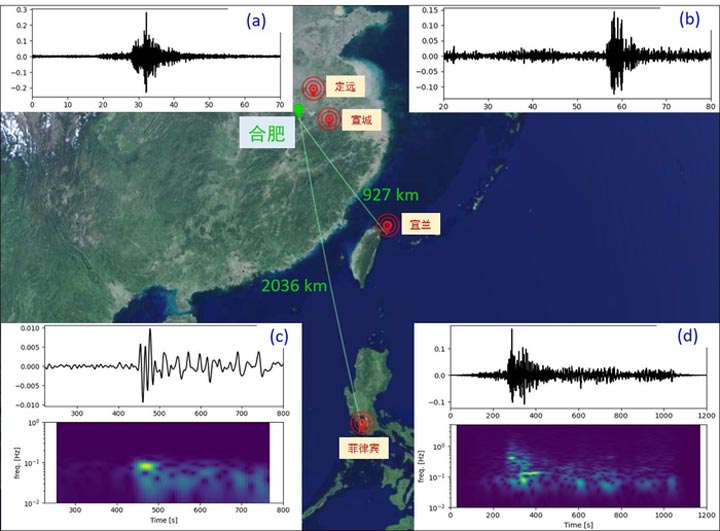Optical fibers successfully detect earthquakes

Earthquakes detected by the DAS system.
Credit: CHEN Yang et al
When it comes to optical fibers, the underground optical cables that transmit tons of information at a time are more familiar to us. Few would ever associate optical fibers with earthquake detection.
Recently, researchers from the University of Science and Technology of China (USTC) of the Chinese Academy of Sciences (CAS) successfully developed a Distributed Acoustic/Vibration Sensing (DAS/DVS) system with independent intellectual property rights. Taking advantage of the existing communication optical cables, this system can be applied to earthquake detection, geological hazard prediction, subsurface structure imaging and so on.
When an earthquake occurs, the optical cable will be stretched or compressed due to the strain from seismic waves. As a result of elasto-optical effect of coherent laser in fiber optic medium, the amplitude as well as the phase of Rayleigh Scattering will be changed. Thus, by receiving and demodulating Rayleigh backscattering, information about seismic waves can be obtained. The DAS technology takes advantage of the mentioned elasto-optical effect to detect and transmit external oscillation and sound wave signals. With a series of merits like excellent anti-interference performance, high integration level, long-distance transmission, DAS technology has created a new path for earthquake detection and subsurface structure imaging.
The key technology of this system includes DAS laser sources, detection of coherent light, demodulation of beat frequency signal and algorithm. And the equipment now has the capacity of detecting frequency between 10 mHz to 20 kHz, with positional accuracy of 3.5m and detection length of up to 40km.
Since deployed at Mount Zipeng in Hefei, the DAS equipment has successfully detected a magnitude-2.3 earthquake in Dingyuan County, a 2.7-magnitude earthquake in Xuancheng, a magnitude-6.6 earthquake in the Philippines and many other regional and global earthquakes.
When it comes to optical fibers, the underground optical cables that transmit tons of information at a time are more familiar to us. Few would ever associate optical fibers with earthquake detection.
Recently, researchers from the University of Science and Technology of China (USTC) of the Chinese Academy of Sciences (CAS) successfully developed a Distributed Acoustic/Vibration Sensing (DAS/DVS) system with independent intellectual property rights. Taking advantage of the existing communication optical cables, this system can be applied to earthquake detection, geological hazard prediction, subsurface structure imaging and so on.
When an earthquake occurs, the optical cable will be stretched or compressed due to the strain from seismic waves. As a result of elasto-optical effect of coherent laser in fiber optic medium, the amplitude as well as the phase of Rayleigh Scattering will be changed. Thus, by receiving and demodulating Rayleigh backscattering, information about seismic waves can be obtained. The DAS technology takes advantage of the mentioned elasto-optical effect to detect and transmit external oscillation and sound wave signals. With a series of merits like excellent anti-interference performance, high integration level, long-distance transmission, DAS technology has created a new path for earthquake detection and subsurface structure imaging.
The key technology of this system includes DAS laser sources, detection of coherent light, demodulation of beat frequency signal and algorithm. And the equipment now has the capacity of detecting frequency between 10 mHz to 20 kHz, with positional accuracy of 3.5m and detection length of up to 40km.
Since deployed at Mount Zipeng in Hefei, the DAS equipment has successfully detected a magnitude-2.3 earthquake in Dingyuan County, a 2.7-magnitude earthquake in Xuancheng, a magnitude-6.6 earthquake in the Philippines and many other regional and global earthquakes.
Media Contact
Jane fan
qfan@ustc.edu.cn
www.ustc.edu.cn
All latest news from the category: Information Technology
Here you can find a summary of innovations in the fields of information and data processing and up-to-date developments on IT equipment and hardware.
This area covers topics such as IT services, IT architectures, IT management and telecommunications.
Newest articles

Properties of new materials for microchips
… can now be measured well. Reseachers of Delft University of Technology demonstrated measuring performance properties of ultrathin silicon membranes. Making ever smaller and more powerful chips requires new ultrathin…

Floating solar’s potential
… to support sustainable development by addressing climate, water, and energy goals holistically. A new study published this week in Nature Energy raises the potential for floating solar photovoltaics (FPV)…

Skyrmions move at record speeds
… a step towards the computing of the future. An international research team led by scientists from the CNRS1 has discovered that the magnetic nanobubbles2 known as skyrmions can be…





















